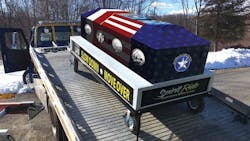I had the opportunity to do a ride-along with a mobile service truck repair technician. It was a real eye opener for two key reasons. One is the versatility and skill of these types of technicians. The bigger revelation, however, was just how dangerous it is to work alongside a roadway, and highways in particular.
The technician told me his job has become considerably more dangerous with the growth of distracted drivers, which adds to the dangers from drivers who are careless or impaired.
Sadly, it happens too frequently. Mobile service technicians, towers, law enforcement officials, first responders, DOT workers, utility crew members and others who work on the side of the road get struck by passing vehicles. This typically results in injuries and even death.
Common courtesy is to slow down or change lanes when approaching an “incident” on the side of the road. Sadly, there is a lack of such considerate behavior nowadays.
Awareness
To help ensure the safety of those who work on or use our nation’s roadways, “slow down, move over” laws have been enacted. Their primary intent is to reduce both the frequency of struck-by incidents and their severity.
These laws also help reduce the frequency and severity of secondary crashes involving approaching vehicles.
While slow down, move over laws vary by state, each one basically requires motorists to cautiously move over one lane – or slow down if changing lanes is not possible – when passing any vehicles on the side of a road with flashing lights. All 50 states have these laws.
Here is a startling statistic: According to a national poll conducted by Mason Dixon Polling & Research, 71 percent of Americans have not heard of slow down, move over laws.
A rundown of these laws by state can be found online within AAA’s Digest of Motor Laws at: www.drivinglaws.aaa.com/tag/move-over-law.
The first “move over” law originated in South Carolina in 1996 after a paramedic was struck and killed while responding to a crash, according to the National Highway Traffic Safety Administration – a U.S. DOT agency charged with regulating vehicle performance standards and partnerships with state and local governments to reduce deaths, injuries and economic losses from motor vehicle crashes.
A Special Casket
To bring public awareness to the slow down, move over laws, plus reduce the rate of casualties from struck-by vehicle accidents, American Towman Magazine is leading a campaign called the Spirit Ride.
The campaign features a custom-designed and built ceremonial Spirit Casket painted red, white and blue. The design has an American Flag motif with a section of vertical bars symbolizing the blood sacrificed (red), the spirit of those killed (white) and the loss and emotional devastation to family members of the fallen (blue).
The Sprit Casket will be relayed across the nation in a zig-zag route by more than 200 volunteer towing companies. It will ride atop a vehicle carrier bed.
The Spirit Ride is expected to begin before the end of this year.
About the Author

